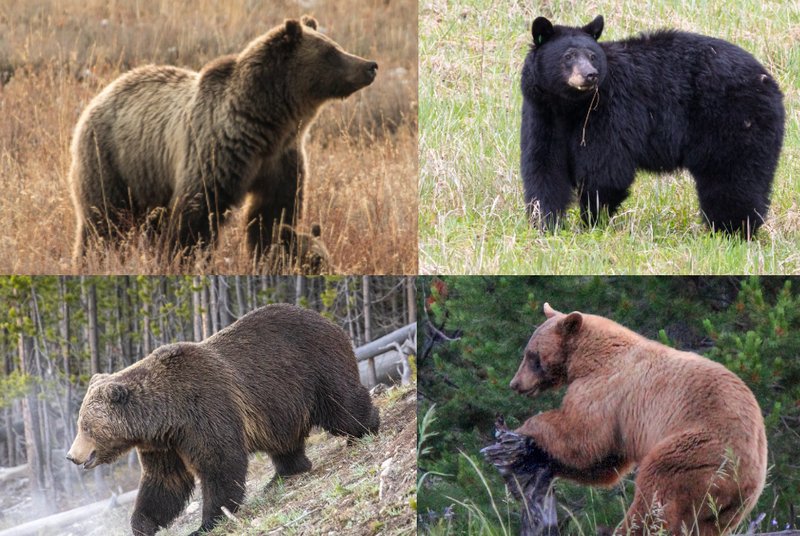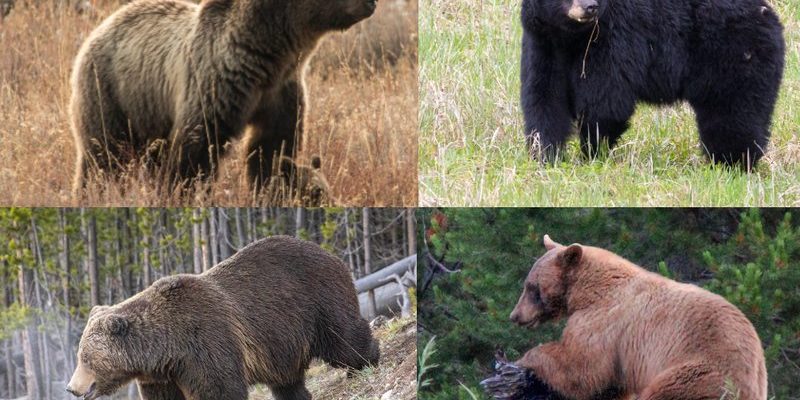
Imagine you’re at a wildlife park, and you see a bear-like creature lumbering around. Is it a grizzly? Or could it be one of its cousins? To help you navigate this bear-sized mystery, let’s explore ten animals that resemble the grizzly bear and break down how you can tell them apart.
1. American Black Bear
The American black bear is probably the closest relative to the grizzly, sharing a lot of similarities in size and habitat. Adult black bears can weigh between 100 to 600 pounds, making them a bit smaller than grizzlies, which can tip the scales at over 800 pounds.
You can spot a black bear by its sleek, shorter snout and lack of the pronounced shoulder hump that grizzlies have. Sometimes, black bears can also exhibit a range of colors—from black to brown, cinnamon, and even blonde! So if you see a bear that looks like it’s wearing a shiny black coat, you might have spotted a black bear instead of a grizzly.
Habitat Preferences
While both species enjoy forested areas, black bears often prefer to roam in wooded regions, whereas grizzlies tend to inhabit more open terrains like mountains and tundras. So, if you’re hiking and you encounter a bear in a dense thicket, it’s more likely to be a black bear.
2. Polar Bear
At first glance, the polar bear may not seem like a close relative of the grizzly. However, recent studies show they share a common ancestor. Polar bears are larger, typically weighing between 900 and 1,600 pounds, with a distinct white or yellowish coat that’s perfect for blending into icy environments.
To differentiate between the two, focus on the polar bear’s long, narrow muzzle and larger feet, which are designed for swimming and walking on ice. While grizzlies have a more rounded face and a powerful build, polar bears look like they were built for navigating the Arctic terrain.
Diet Differences
Another key difference is diet. Polar bears primarily feast on seals and have a carnivorous diet, while grizzlies are omnivores, enjoying berries, fish, and small mammals. So, if you see a bear munching on sea ice, it’s definitely a polar bear!
3. Kodiak Bear
The Kodiak bear is often compared to the grizzly because it’s one of the largest members of the bear family, much like its cousin. Found in Alaska, Kodiaks can weigh up to 1,500 pounds. But here’s the kicker: Kodiaks tend to be bulkier with a broader head than grizzlies.
When you observe a Kodiak bear, look for its longer claws and thicker coat, which can make it seem a bit more robust. They mainly inhabit the Kodiak Archipelago, which is another geographic distinction from grizzlies that are more widespread across the continental U.S.
Behavioral Traits
Kodiak bears also tend to be less aggressive towards humans than grizzlies, largely because they live in less populated areas. If you’re out in the wilderness and spot a hefty bear, remembering this can help ease your mind—at least a little!
4. Asiatic Black Bear
The Asiatic black bear, or moon bear, has a striking resemblance to the grizzly, particularly in its size—usually between 220 to 440 pounds. Their shaggy black fur, especially around the chest where they have a distinctive white crescent marking, can make them look quite similar.
The key to distinguishing them lies in the facial features. Asiatic black bears have a more pointed snout and a smaller body compared to grizzlies. They also have longer claws, which they use to climb trees more adeptly than their heavier cousins.
Habitat and Range
These bears are primarily found in the forests of Asia, from the Himalayas to Japan, which is quite a different environment than what grizzlies call home. If you’re ever in Asia and spot a bear in a forest, chances are it’s an Asiatic black bear.
5. Spectacled Bear
The spectacled bear, or Andean bear, is South America’s only bear species and has a unique look that somewhat resembles grizzlies. These bears weigh around 220 to 440 pounds, but are generally smaller than grizzlies.
What sets them apart is the distinct markings around their eyes, giving them the name “spectacled.” This unique facial feature, along with their slender build and long limbs, makes it easy to differentiate them from the broader, stronger grizzly.
Dietary Preferences
Like their Asian counterparts, spectacled bears also lean more toward herbivorous diets, munching on fruits and vegetation rather than meat. This difference in diet can signal a divergence in behavior as well.
6. Sun Bear
Sun bears are the smallest bear species, weighing only about 60 to 150 pounds. They have a relatively small, stocky build, and their fur is short and sleek with a distinctive orange to cream-colored crescent marking on their chest.
The biggest giveaway that it’s a sun bear and not a grizzly is its size and the short snout. Grizzlies, with their pronounced features and hefty weight, are hard to miss, while sun bears are much more unassuming.
Living Habits
Sun bears are primarily found in Southeast Asia and are excellent climbers, often seeking out trees for food. If you see a bear playing or foraging in the upper limbs of a tree, it’s likely a sun bear, not a grizzly.
7. Sloth Bear
With its shaggy coat and elongated snout, the sloth bear does bear a resemblance to a grizzly, especially when it comes to its larger size. Sloth bears can weigh anywhere from 200 to 300 pounds, making them smaller but still comparable in a way.
A telltale sign of a sloth bear is its unique feeding habits. They primarily consume termites and ants, using their long snouts to suck up their favorite snacks. If you see a bear with a busy mouth full of insects, it’s most certainly a sloth bear and not just a hungry grizzly.
Behavioral Quirks
These bears are also nocturnal and less aggressive, sticking to a more solitary lifestyle compared to grizzlies. Observing their unique foraging behaviors can be a fascinating experience.
8. Giant Panda
While giant pandas are primarily herbivorous, their stocky build and black-and-white coloring can make them seem similar to grizzlies from a distance. However, they weigh around 220 to 330 pounds, significantly less than a grizzly.
Pandas have a more rounded face with larger eyes and a more beautiful demeanor. If you see a bear munching on bamboo, it’s definitely a panda and not a grizzly looking for a snack.
Ecosystem Significance
Giant pandas play a crucial role in their ecosystem, specifically in promoting the health of bamboo forests. So, if you’re hiking in a panda habitat in China, just know it’ll be quite different from a typical grizzly habitat.
9. Eurasian Brown Bear
The Eurasian brown bear is another close relative of the grizzly. It can be found across Europe and Asia, and sizes can vary greatly. They typically weigh between 300 to 1,200 pounds and are similar in appearance with their broad heads and strong bodies.
One way to spot the difference is by the coat color and texture; Eurasian browns tend to have a lighter, often sparser coat than their North American cousins. If you see a bear in Europe, just remember to look for those subtle differences!
Habitat and Behavior
Eurasian brown bears also tend to favor denser forests compared to the more open areas preferred by grizzlies. Their adaptability to different environments allows them to thrive in varied conditions.
10. Florida Black Bear
Last but not least, the Florida black bear resembles a smaller grizzly due to its stocky build. Weighing in at about 100 to 400 pounds, this bear is the state’s only native bear species.
The biggest difference is their smaller size and lack of the grizzly’s shoulder hump. Florida black bears have a more rounded back and a longer, narrower head. If you find yourself in the Sunshine State, there’s a solid chance you might see one of these bears roaming the forests.
Conservation Status
Florida black bears are considered a threatened species due to habitat loss and human interaction. This adds another layer of importance to knowing how to identify them; these bears need our respect and protection.
In summary, while the grizzly bear is a formidable and iconic creature, it shares the stage with several animals that exhibit similar features. By knowing these differences, you can appreciate each species for their unique traits and roles in the ecosystem. Next time you come across a bear-like creature, you’ll be well-prepared to identify if it’s a grizzly or one of its fascinating cousins. Happy wildlife watching!

